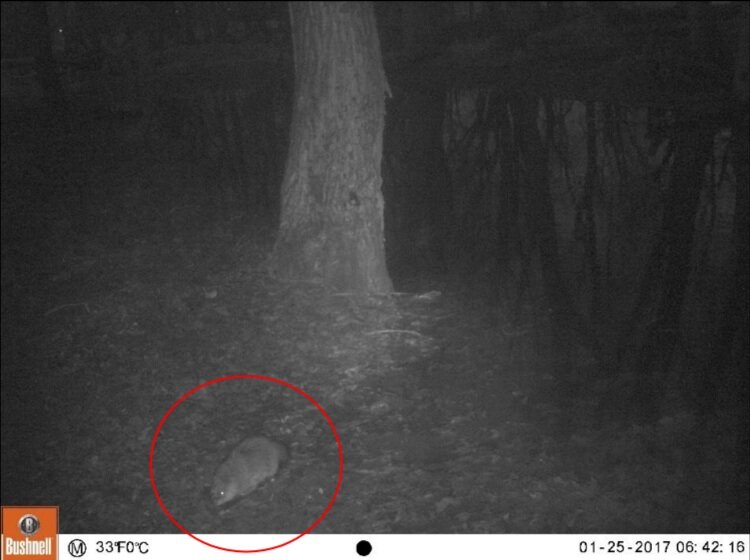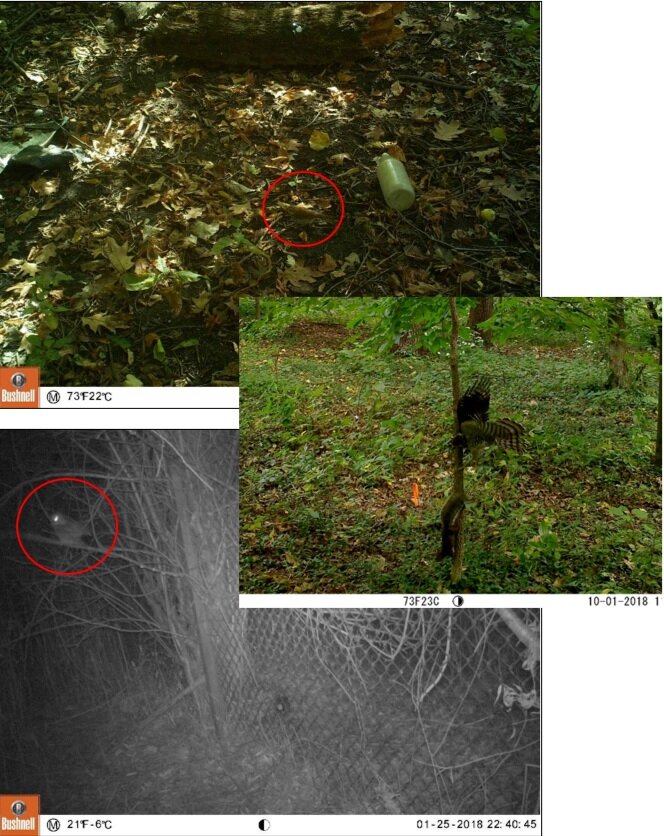Less Commonly Seen Animals
Chipmunk
A member of the squirrel family, chipmunks have smaller, less bushy tails than a typical tree squirrel and sport signature white-and-brown stripes around the eye and along each side of the typically brown/tan body. Cheek pouches are used to carry food. Typically diurnal.
Often confused with: flying squirrel
Key characteristics:
Smaller than gray and fox squirrels, larger than mice
Reddish brown/brown/gray coloration with lighter-colored belly
Alternating black and white stripes down back
Short, hairy tail
May appear similar to mice in night photos with eye glare, but look for a larger size and stripes down the back
Eastern Cottontail
Characterized by large, dark eyes, long pointed ears, brown/gray fur and a short, fluffy, white tail.
Often confused with: gray squirrels, fox squirrels
Key characteristics:
Large ears stand straight up
Brown to gray coat
Small, white tail
Large eyes close to ground in night photos (look for other evidence to distinguish from other animals, such as opossum, raccoon, etc.; if there is only one eye, this points to rabbits or deer, as their eyes are on each side of their head, but rabbits will be closer to the ground than deer)
Muskrat
This animal normally has red/brown fur and a black tail with small dark eyes. The fur-less, scaly tail is half of its total length. Much smaller than a beaver. Their front paws are clawed while the rear feet are semi-webbed and clawed. These animals live in semi-aquatic habitats. Typically nocturnal.
Often confused with: beaver, opossum, woodchuck
Key Characteristics:
Dark coat
Partially webbed hind feet
Dark, scaly tail
Size similar to a rabbit
North American Beaver
Beavers have brown/reddish fur and large sharp front teeth, clawed front feet, webbed back feet, a round body and a large flat tail. The second largest rodent in the world, beavers are semi-aquatic and primarily nocturnal.
Often confused with: muskrat, woodchuck
Key Characteristics:
Wide, flat tail shaped like a paddle
Round shape
Typical rodent teeth (2 large upper and lower incisors for gnawing on wood)
Webbed hind feet
Thick, dark fur
If it is swimming in water, look for large size, small eyes compared to overall size, and wide, paddle-like tail (muskrat is smaller overall and has a slender, scaly tail)
Woodchuck, aka groundhog
Related to squirrels, woodchucks are larger than tree or flying squirrels and have a brown/gray furry coat, clawed feet, small dark eyes and rounded ears, with a short, dark, brushy tail. Typically diurnal.
Often confused with: beaver, muskrat, fox squirrel, gray squirrel
Key characteristics:
-Stocky appearance
-Short, dark brown to black, bushy tail
-Short round ears
-Grizzled fur with variety of gray and brown tones
-Larger than gray and fox squirrels
-Terrestrial (vs. beaver or muskrat)
American Mink
Related to otters, weasels, and ferrets, mink have long, low-slung bodies, with pointed snouts and dark eyes. They also have clawed feet with webbing and thick brown fur that sheds water quickly. These animals live in semi-aquatic habitats.
Often confused with: long-tailed weasel, melanistic gray squirrel
Key characteristics:
Long, slender body
Dark fur covering the whole body (long-tailed weasels have dark fur on their back, but have lighter-colored bellies)
Long tail tipped with black
May have white patches on throat or chest
Larger and stockier than long-tailed weasels
Short, round ears that are not highly visible (long-tailed weasel ears are more noticeable)
Flying Squirrel
A member of the squirrel family, this animal has large dark eyes, loose skin between the front and back legs, clawed feet, and a long, bushy tail (not as bushy as a tree squirrel’s tail) with dark fur on top and light below. Flying squirrels are strictly nocturnal. Because they are rare, please always highlight photos of this animal!
Often confused with: chipmunk, gray squirrel, fox squirrel
Key characteristics:
-Large eyes
-Light gray/brown fur
-Bushy tail (shorter and less bushy than tree squirrels)
-Extra, loose skin between forelimbs and hind limbs
-Smaller than a gray or fox squirrel, much smaller tail, and nocturnal (other tree squirrels are diurnal)
Mouse
A very small animal with a long snout, round ears, and a long hairless tail. Mice can be found in and around grasslands and homes.
Often confused with: rat
Key Characteristics:
Long, hairless tail
Large, round ears
Large eyes compared to body size
Rat
Larger than a mouse with a pointy nose, round ears, and a long, hairless, pinkish tail. Many people think they only roam the subway and sewers, but it is not uncommon to see then running across the street above ground.
Often confused with: opossum, mouse
Key characteristics:
Long, hairless tail
Pointy nose
Head typically lower to ground than round rump
Larger than mouse
Bird (NOT Turkey)
Many bird species will be captured in our photos, ranging from robins and cardinals to Canada geese and wild turkeys. Birds can be found nesting in trees, foraging for food on the ground, or swimming in water. We do record wild turkeys species but for all other bird species please just choose “bird”. Feel free to write the species ID in the comments if you know it! (e.g. hawk; heron; owl)

















